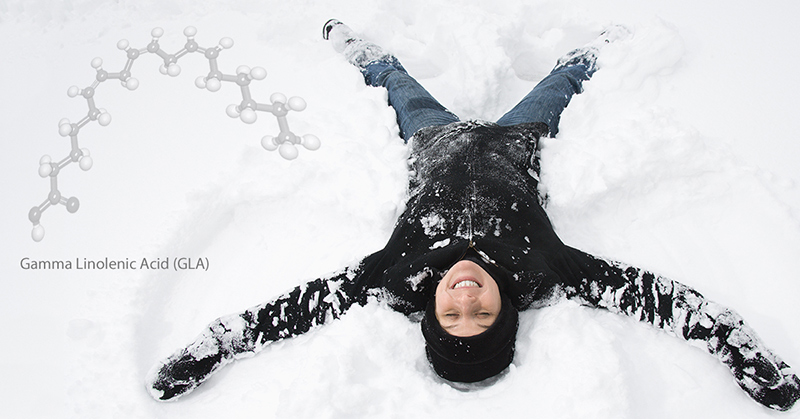For Menopause, the omega-6 beneficial fat Gamma Linolenic Acid (GLA) frequently eases hot flashes, sleep disruption, irritability, and vaginal dryness in early menopause. Supplementing GLA stabilizes hormone-related symptoms and calms inflammation. We have seen GLA give excellent relief for of breast tenderness from several causes including perimenopausal hormone surges, fibrocystic breast problems, or PMS. Women who are known to have low levels of GLA, a unique omega-6 fatty acid, have greater symptoms of menopause, as well as suffering more PMS in their younger years.
 It is important that GLA doses are sufficiently high to provide relief for menopausal and hormonal symptoms. Most women need over 200mg of GLA daily. The low levels of GLA in evening primrose oil (9%) or blackcurrant seed or borage oil (17-20%) would require up to twelve capsules daily for therapeutic benefits! By contrast, one to two capsules daily of a high-potency GLA concentrate can give excellent help with hormone balancing.
It is important that GLA doses are sufficiently high to provide relief for menopausal and hormonal symptoms. Most women need over 200mg of GLA daily. The low levels of GLA in evening primrose oil (9%) or blackcurrant seed or borage oil (17-20%) would require up to twelve capsules daily for therapeutic benefits! By contrast, one to two capsules daily of a high-potency GLA concentrate can give excellent help with hormone balancing.
Research suggests that women with PMS and increased menopause symptoms later in life appear to have a blockage of the enzyme needed to make this key fatty acid, which is the building block of “good” eicosanoids. Eicosanoids work like hormones, but they do not like to travel. Eicosanoids go by the nickname ‘local hormones’ because they act on cells close to their site of production. Women with a defect in their ability to make GLA, have problems processing essential fats. Their bodies have difficulty generating enough of the ‘good’ prostaglandins, which have an essential role in reducing inflammation. For menopause, GLA can give excellent relief of symptoms, especially when exacerbated by inflammation.
GLA is much less commonly consumed in standard American diets, than other omega-6 fatty acids. As our bodies may not be able to form it from food, we often need supplemental GLA. Although its precursor, linoleic acid, is found in nuts, seeds, and vegetable oils, its ready conversion into GLA can be hampered by disorders like diabetes, the natural aging process, poor diet including excess saturated fats or sugar, or inadequate intake of vitamin C, magnesium, zinc, or B-complex vitamins. Menopausal symptoms can be worse for women who are unable to adequately convert linoleic acid to GLA, and who therefore can have higher levels of inflammatory prostaglandins.
From GLA, the body forms prostaglandin E1 and the thromboxane A1, both of which can reduce inflammation, inhibit the formation of pro-inflammatory leukotrienes, improve blood flow, and inhibit platelet clumping. Prostaglandin E1 also has a role in regulation of healthy immune system function. As early as 1995, there was so much interest in the potential of GLA for medical use, that the Health and Nutrition Division of the American Oil Chemists’ Society convened an international conference to examine the biological value of GLA. This meeting brought together world-renowned experts who explored in-depth the biochemistry, metabolism, nutritional, and clinical uses of GLA. This conference examined hundreds of studies and launched an equal number examining its mechanism of action and anti-inflammatory benefits, and resulted in a book that summarized the studies to date.2
Studies show that a sufficient daily intake of between 200-1,000mg of GLA is needed for menopausal relief and important gynecological, breast, skin, and anti-inflammatory benefits. In our clinic, we regularly see doses of 200-700mg daily of GLA giving excellent relief for menopause symptoms; and for accompanying perimenopausal breast tenderness, as well as PMS and fibrocystic breast problems.
Recommendations:
GLA, Gamma Linolenic Acid: 200-250mg per capsule, one to three capsules daily, fine to take with any meal; or as directed by your healthcare provider.
References
- Eicosanoids: Definition, Function, Types & Effects, Dr. Rebecca Gillaspy, University of Phoenix. April 7, 2015.
- Mills, David E. Gamma-linolenic acid: Metabolism and its roles in nutrition and medicine. AOCS Publishing, 1996
- Fan YY, Chapkin RS. Importance of dietary gamma-linolenic acid in human health and nutrition. J Nutr 1998;128:1411-4.
- Guivernau M, Meza N, Barja P, Roman O. Clinical and experimental study on the long-term effect of dietary gamma-linolenic acid on plasma lipids, platelet aggregation, thromboxane formation, and prostacyclin production. Prostaglandins Leukot Essent Fatty Acids 1994;51:311-6.
- Johnson MM, Swan DD, Surette ME. Dietary supplementation with gamma-linolenic acid alters fatty acid content and eicosanoid production in healthy humans. J Nutr 1997;127:1435-44.
- Ryu A, Kim TH. Premenstrual syndrome: A mini review. Maturitas. 2015 Dec;82(4):436-40. Epub 2015 Aug 28.